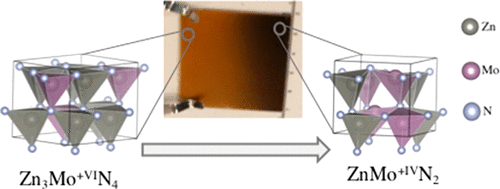当前位置:
X-MOL 学术
›
J. Am. Chem. Soc.
›
论文详情
Our official English website, www.x-mol.net, welcomes your feedback! (Note: you will need to create a separate account there.)
Redox-Mediated Stabilization in Zinc Molybdenum Nitrides
Journal of the American Chemical Society ( IF 15.0 ) Pub Date : 2018-03-01 , DOI: 10.1021/jacs.7b12861 Elisabetta Arca 1 , Stephan Lany 1 , John D. Perkins 1 , Christopher Bartel 2 , John Mangum 3 , Wenhao Sun 4 , Aaron Holder 1, 2 , Gerbrand Ceder 4, 5 , Brian Gorman 3 , Glenn Teeter 1 , William Tumas 1 , Andriy Zakutayev 1
Journal of the American Chemical Society ( IF 15.0 ) Pub Date : 2018-03-01 , DOI: 10.1021/jacs.7b12861 Elisabetta Arca 1 , Stephan Lany 1 , John D. Perkins 1 , Christopher Bartel 2 , John Mangum 3 , Wenhao Sun 4 , Aaron Holder 1, 2 , Gerbrand Ceder 4, 5 , Brian Gorman 3 , Glenn Teeter 1 , William Tumas 1 , Andriy Zakutayev 1
Affiliation

|
We report on the theoretical prediction and experimental realization of new ternary zinc molybdenum nitride compounds. We used theory to identify previously unknown ternary compounds in the Zn-Mo-N systems, Zn3MoN4 and ZnMoN2, and to analyze their bonding environment. Experiments show that Zn-Mo-N alloys can form in broad composition range from Zn3MoN4 to ZnMoN2 in the wurtzite-derived structure, accommodating very large off-stoichiometry. Interestingly, the measured wurtzite-derived structure of the alloys is metastable for the ZnMoN2 stoichiometry, in contrast to the Zn3MoN4 stoichiometry, where ordered wurtzite is predicted to be the ground state. The formation of Zn3MoN4-ZnMoN2 alloy with wurtzite-derived crystal structure is enabled by the concomitant ability of Mo to change oxidation state from +VI in Zn3MoN4 to +IV in ZnMoN2, and the capability of Zn to contribute to the bonding states of both compounds, an effect that we define as "redox-mediated stabilization". The stabilization of Mo in both the +VI and +IV oxidation states is due to the intermediate electronegativity of Zn, which enables significant polar covalent bonding in both Zn3MoN4 and ZnMoN2 compounds. The smooth change in the Mo oxidation state between Zn3MoN4 and ZnMoN2 stoichiometries leads to a continuous change in optoelectronic properties-from resistive and semitransparent Zn3MoN4 to conductive and absorptive ZnMoN2. The reported redox-mediated stabilization in zinc molybdenum nitrides suggests there might be many undiscovered ternary compounds with one metal having an intermediate electronegativity, enabling significant covalent bonding, and another metal capable of accommodating multiple oxidation states, enabling stoichiometric flexibility.
中文翻译:

氧化还原介导的氮化锌钼稳定性
我们报告了新型三元锌钼氮化物化合物的理论预测和实验实现。我们使用理论来识别 Zn-Mo-N 系统中以前未知的三元化合物 Zn3MoN4 和 ZnMoN2,并分析它们的键合环境。实验表明,Zn-Mo-N 合金可以在纤锌矿衍生结构中形成从 Zn3MoN4 到 ZnMoN2 的广泛成分范围,适应非常大的非化学计量。有趣的是,测量的合金纤锌矿衍生结构对于 ZnMoN2 化学计量是亚稳态的,与 Zn3MoN4 化学计量相反,其中有序纤锌矿被预测为基态。具有纤锌矿衍生晶体结构的 Zn3MoN4-ZnMoN2 合金的形成是通过 Mo 将氧化态从 Zn3MoN4 中的 +VI 变为 ZnMoN2 中的 +IV 的伴随能力实现的,以及 Zn 对两种化合物的键合状态做出贡献的能力,我们将这种效应定义为“氧化还原介导的稳定化”。Mo 在 +VI 和 +IV 氧化态下的稳定化是由于 Zn 的中间电负性,这使得 Zn3MoN4 和 ZnMoN2 化合物中的显着极性共价键成为可能。Zn3MoN4 和 ZnMoN2 化学计量之间 Mo 氧化态的平滑变化导致光电特性的连续变化——从电阻和半透明 Zn3MoN4 到导电和吸收 ZnMoN2。报道的氧化还原介导的氮化锌钼稳定性表明可能存在许多未被发现的三元化合物,其中一种金属具有中等电负性,从而能够形成显着的共价键合,
更新日期:2018-03-01
中文翻译:

氧化还原介导的氮化锌钼稳定性
我们报告了新型三元锌钼氮化物化合物的理论预测和实验实现。我们使用理论来识别 Zn-Mo-N 系统中以前未知的三元化合物 Zn3MoN4 和 ZnMoN2,并分析它们的键合环境。实验表明,Zn-Mo-N 合金可以在纤锌矿衍生结构中形成从 Zn3MoN4 到 ZnMoN2 的广泛成分范围,适应非常大的非化学计量。有趣的是,测量的合金纤锌矿衍生结构对于 ZnMoN2 化学计量是亚稳态的,与 Zn3MoN4 化学计量相反,其中有序纤锌矿被预测为基态。具有纤锌矿衍生晶体结构的 Zn3MoN4-ZnMoN2 合金的形成是通过 Mo 将氧化态从 Zn3MoN4 中的 +VI 变为 ZnMoN2 中的 +IV 的伴随能力实现的,以及 Zn 对两种化合物的键合状态做出贡献的能力,我们将这种效应定义为“氧化还原介导的稳定化”。Mo 在 +VI 和 +IV 氧化态下的稳定化是由于 Zn 的中间电负性,这使得 Zn3MoN4 和 ZnMoN2 化合物中的显着极性共价键成为可能。Zn3MoN4 和 ZnMoN2 化学计量之间 Mo 氧化态的平滑变化导致光电特性的连续变化——从电阻和半透明 Zn3MoN4 到导电和吸收 ZnMoN2。报道的氧化还原介导的氮化锌钼稳定性表明可能存在许多未被发现的三元化合物,其中一种金属具有中等电负性,从而能够形成显着的共价键合,



























 京公网安备 11010802027423号
京公网安备 11010802027423号